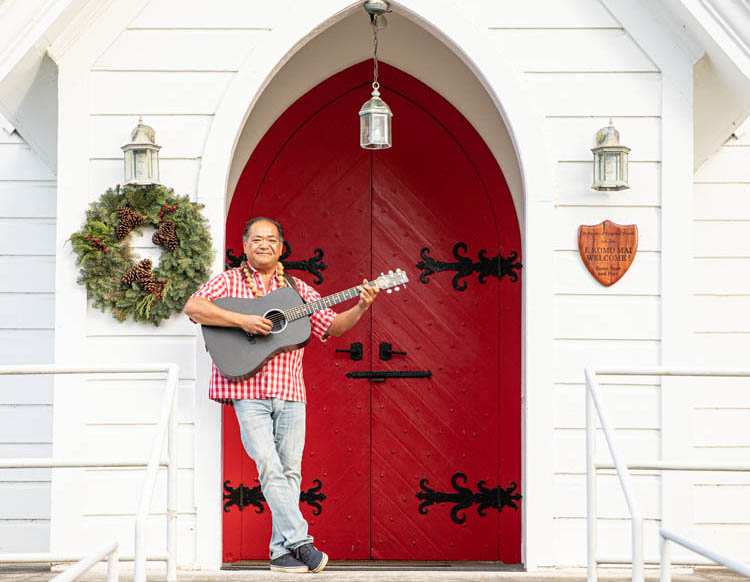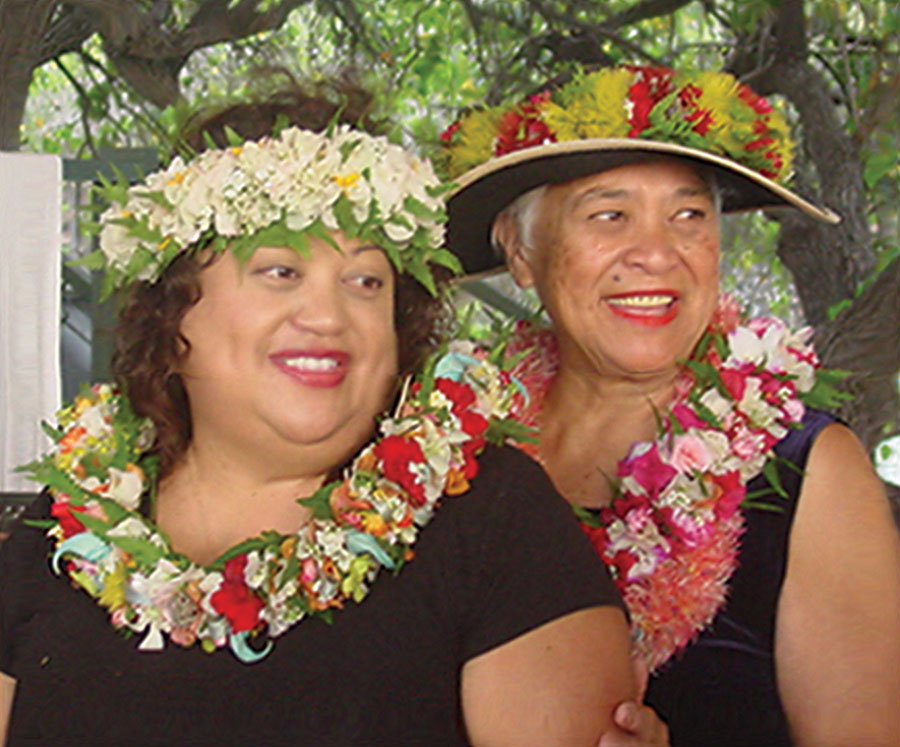
Kolohe Diamond: Aunty Maile Spencer Napoleon

By Catherine Tarleton
It could be “Twilight at Kalahuipua‘a,” or another cultural event on Hawai‘i Island where people gather to enjoy music, hula, and camaraderie by the ocean. As the audience waits for the first strum of ‘ukulele, the sun begins its slow, colorful embrace of the horizon, and a lovely Hawaiian woman makes her way through the crowd with a basket of flowers. Small in stature and with a generous heart so big it glows, this is how teacher, artisan, lei-maker, and healer Aunty Maile Spencer Napoleon says aloha.
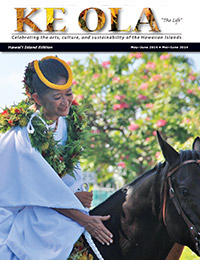
“Merry Christmas,” she says as she always does, regardless of the season. “Would you like a lei?” Her smooth hands fit the lei po‘o on the crown of an unsuspecting head. From behind, she can’t see the smile illuminating that face, although it is reflected in faces all around.
“People smile, they sit a little taller. It’s kind of a spiritual lift,” says Aunty Maile’s friend Anne Dressel. “You see it moving through the crowd.”
“My daughter asked me one time, ‘Mom, why do you make leis and give them away when you could make money?’” says Aunty Maile. “I told her, ‘I’m going to buy your ticket and you come.’” When daughter Lehuanani did come to see for herself, Mom gave her the basket to carry.
“Look for the saddest face,” says Aunty Maile. At one time, she only gave lei to divorcees, saying, “Either you’re happy, or sad, or confused—but either way you need to get lei’d!” She laughs in that naughty kolohe way, a style of hula she’s also famous for, and the air around her, like her eyes, twinkles.
She’s given thousands of lei away in her 73 years, many crafted from what she calls the “free way flowers,” bougainvillea, because they grow free on the side of the road. Once she was admonished by a police officer, while picking free way flowers at 4:30am.

“He tapped me on the shoulder and I just kept picking flowers,” says Aunty Maile. “When he told me I wasn’t supposed to pick there, I said, ‘Oh, good. Can you call Governor Cayetano? He asked me to go to the airport and give leis, and he didn’t send me any money or any flowers… so you let me know.’”
Maile grew up in North Kohala, in the home of her paternal grandmother Abigail Ka‘omea Alapa‘i. In the Hawaiian hānai tradition, grandmother, “Kūkū,” helped raise Maile and her younger brother, as her parents’ home was already filled with children: seven nieces and nephews, plus two older sisters and a brother.
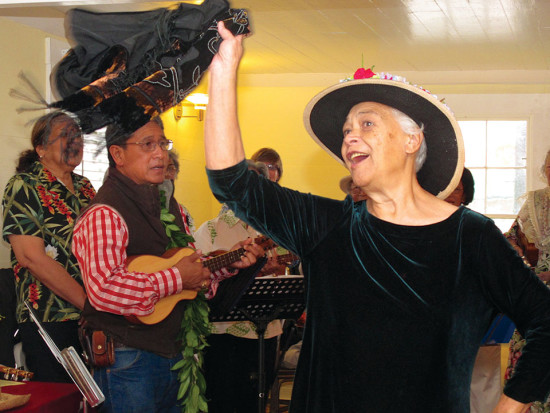
She went to her mother’s house to learn to make flower lei, in the haku style, traveling across town by five-cent taxi ride. To supplement the family income, mother and daughter would make lei pāpale (hatband lei-making) for Kahua Ranch and Parker Ranch paniolo, at $3-5 each, to weight their cowboy hats and keep them secure in the wind.
“I learned to make leis, because I didn’t want to get spanked,” says Aunty Maile. “I’m glad I learned. I love doing it.”
From Kūkū, Maile learned lei hulu (feather lei-making), and lomilomi (massage), among many other things. She remembers fondly watching Kūkū work, following her every move and asking what she was doing.
“She always said, in her way, ‘Come. Let me show you,’” says Maile. Descendant of the ali‘i Alapa‘i family, Maile remembers once asking Kūkū, if she was royalty, where was her crown?
“She told me, ‘When you have a talent to create things that come from nature, that is your ali‘i,’” Maile says, holding up her two hands. “‘Those are your ali‘i, when you know how to use your hands. Your two hands, those are your crown.’”
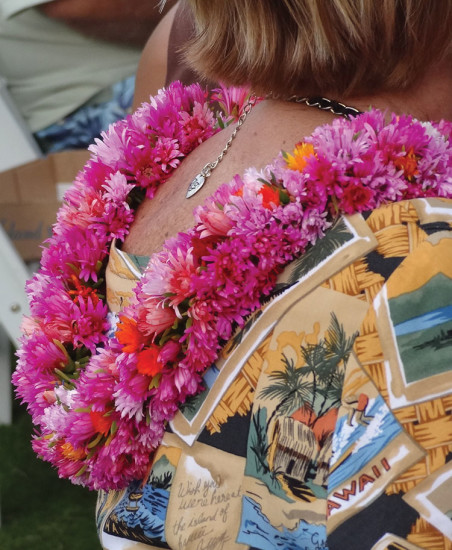 “She would say, ‘If you have a talent of some kind, do it—do it and give it away so you can share the aloha spirit,’” says Maile, near tears. “As a Hawaiian, everything you do only comes from within. Everything I do is from the heart because of my grandmother.”
“She would say, ‘If you have a talent of some kind, do it—do it and give it away so you can share the aloha spirit,’” says Maile, near tears. “As a Hawaiian, everything you do only comes from within. Everything I do is from the heart because of my grandmother.”
Their family, for more than 700 years, lived in Lapakahi (single ridge) on the North Kohala coast. In addition to farmers and fishermen, Maile says the villagers were healers, and that they knew where to dive for clean ocean water, which they drank every 90 days for natural cleansing.
She says there were three rivers coming down to Lapakahi from Pololū. And when sugarcane dominated the land, plantation owners decided to divert the water for agriculture.
“650 people had to move,” says Maile. “One family stayed on until 1960 and then moved to Māhukona.”
Today, Lapakahi State Historical Park is there on the coast, a partially restored Hawaiian village and learning resource.
“I was raised Hawaiian,” says Maile. “The first day of school I came home crying and told my grandmother I’m not going back to school because they only speak English and I don’t speak any English.” Maile says Kūkū immediately took her back to school in a taxi and had a stern talk with the teacher. “She said, ‘you will come to my house and teach her English and I will pay for the taxi,’” says Maile. “It was the first time I ever heard my grandmother speak English.”
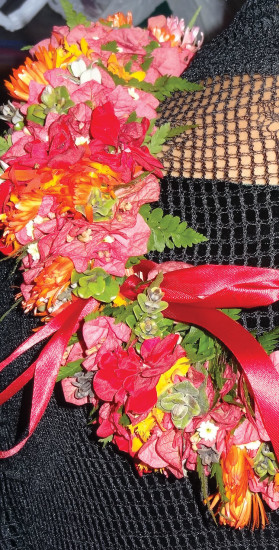 Maile says that as the waves of Chinese, Japanese, Korean, German, Russian, and Portuguese immigrants came to work on the North Kohala plantations, they set up separate “camps” and schools to teach children their native tongues. Even the unions were not in favor of a homogenized workforce. It became clear to the young girl that those who could communicate at all levels had a distinct advantage.
Maile says that as the waves of Chinese, Japanese, Korean, German, Russian, and Portuguese immigrants came to work on the North Kohala plantations, they set up separate “camps” and schools to teach children their native tongues. Even the unions were not in favor of a homogenized workforce. It became clear to the young girl that those who could communicate at all levels had a distinct advantage.
“I thought I’d better damn well learn English,” she says. “Even though it was against my whole being. Once I learned, I loved reading. I was a voracious reader. I wanted to be smart enough to know what all the words meant.”
She graduated from Kohala High School, Class of ‘58, with a $280 scholarship for nursing school on O‘ahu. Tuition was $225, so she used the extra money to take hotel and restaurant classes at Kapi‘olani Tech—stock clerk, waitress, cook and pantry—at only $5 each. At 18, she wanted to join the Air Force, and even with two brothers and a sister in the military, her father objected, protectively.
“He said, ‘The service is not for a woman. When you get big enough, you will know what I mean,’” she says. Instead, she finished school as an LPN, what she calls a “Low Paid Nurse,” making $125 every two weeks.
At age 47, she became a teacher at Waimalu Elementary School, and stayed with the Kupuna Hawaiian Studies Program, teaching grades K-6 for about eight years. “You didn’t have to be certified,” she says. “They had 10 questions, but only asked me two, ‘Do you love children?’ and ‘Do you know how to speak the Hawaiian language?’”
“In the 80s, before we fought for it in the legislature, children were not using Hawaiian or learning Hawaiian, learning the culture as much as they should,” says Maile. “We needed to start teaching in the state school system. People should be able to connect the past to the present, so that we don’t lose our culture. Once we lose the language, we lose our culture.”
In her spare time on weekends, Maile worked for the Office of Hawaiian Affairs at Waimea Falls Park, where she made lei—at $6 per hour. “I would give lei away, share Hawaiian history and culture, anything Hawaiian,” says Maile.
 In 2000, she returned home to Hawai‘i Island to work for her church, and at the same time a job was available at Lapakahi State Historical Park. “I never told the interviewer that my family came from Lapakahi,” says Maile. “I wanted to be hired on my own merits.”
In 2000, she returned home to Hawai‘i Island to work for her church, and at the same time a job was available at Lapakahi State Historical Park. “I never told the interviewer that my family came from Lapakahi,” says Maile. “I wanted to be hired on my own merits.”
It was at Lapakahi in 2003 where Maile met her her soon-to-be close friend Anne Dressel. Anne and her husband had traveled to Hawai‘i Island for the first time with her cousin Bruce Starbuck and his wife. Bruce told Anne she absolutely had to go to Lapakahi to meet Aunty Maile.
“So I did,” says Anne. “And I asked her, “You know anybody who makes those haku leis?” A little embarrassed now by the question, she nods to Aunty for confirmation. “She said, ‘Come next Sunday and bring bougainvillea and raffia and I’ll bring ferns.’ I didn’t even know what raffia was, so she said, ‘Never mind, I’ll bring it.’”
“She did such a wonderful job I couldn’t believe it was her first time,” said Maile.
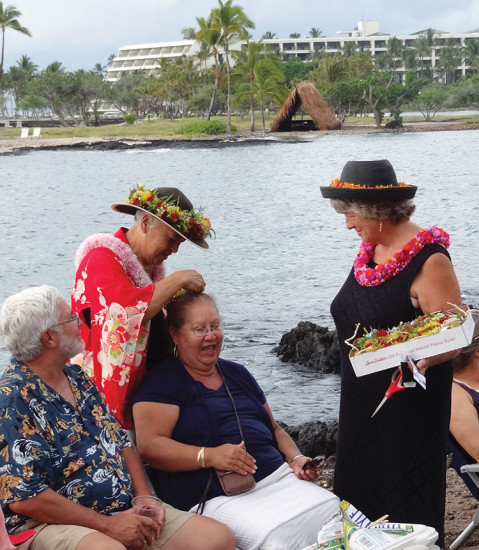
Anne now lives here and is still making lei. In fact, for Maile’s 68th birthday, she made lei for a whole week, so that she’d have more than enough to share at “Twilight.”
“I thought, ‘What can I give Aunty Maile, who doesn’t want anything and gives everything away?” says Anne. She worked tirelessly, 15 minutes on, 10 minutes off, Monday through Friday, and near the end of the week, Maile called to ask if she was going to the event. “I said yes, because I’d been making some leis for it. And when we got there and counted—hers and mine together turned out to be exactly 68, for her 68th birthday. The next year, same thing happened, only it was 69!”
“Aunty Maile is someone who gives and gives,” says Holly Algood of Algood Consulting in North Kohala, another friend, student and fan of Maile’s. “She embodies aloha. She gives and asks nothing in return. Anyone who has attended one of her workshops will tell you her gifts and efforts far exceeded the students’ expectations.”
“Her leis are legendary and recognizable from a distance. She is also an expert carver, pū maker, and poi pounder creator. Maile teaches the mechanics of lomilomi, and more importantly, the attitude and preparation that must accompany the work,” says Holly. “Her goal is to help others feel better and live fuller lives with aloha. Her humor, love of flowers and aloha are infectious and heals us all.”
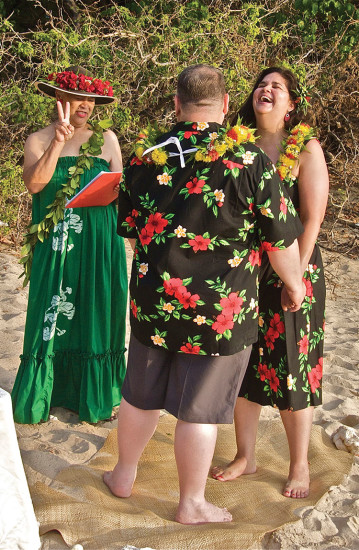
Today, Aunty Maile continues to share her many gifts with friends and strangers. Maile teaches lei making, lomilomi (as taught to her from Kumu Kalua Kaiahua), Huna (which she learned from Serge Kahili King), ku‘i pōhaku (stonework), lauhala weaving, pū‘ili (bamboo rattle, sometimes used for soothing vibrational healing with lomilomi), pū ‘ohe (bamboo trumpet), Pranic healing, Lā‘au Lapa‘au (medicinal plants and healing practices), and Hawaiian philosophy.
An Interfaith Minister since 1991, she also performs wedding ceremonies, rich in aloha, with her custom lei for bride and groom. She travels annually to Hāna, Maui for the Taro Festival, where she demonstrates the painstaking art of chipping stone into poi pounders. Recently she and grandson Alika teamed up to make a step-by-step poi pounder demonstration video and win a Kamehameha Schools competition. She continues to dance, tend her flowers, create and learn new things all the time.
“Hawaiians are not lazy, not stupid,” says Maile, remembering historians who observed Hawaiians resting in the heat of the day while others worked in the sun. “Hawaiians started work at 3:30 or 4:30 in the morning,” says Maile. “People need to come and study before they write about us.” Her twinkling temperament sparks something deeper. A lift to the chin, a flush of ali‘i blood.
“Hawaiians are the smartest people on earth,” she says. “We learned to speak English, we learned to read—because we knew we had to survive in our own native land.” ❖
Lapakahi State Historical Park: Hawaiistateparks.org/parks/brochure_pdfs/hsp_lapakahi_state_historical_park26.pdf
Aunty Maile’s classes and services: AuntyMaile.com
Contact photographer Michael F. O’Brian: ongginui@gmail.com
Uncredited photos by Renée Robinson: AWealthOfWisdom.com
Contact writer Catherine Tarleton: catherinetarleton@gmail.com


